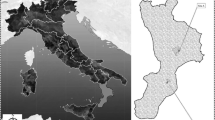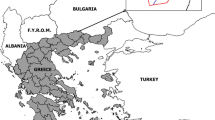Abstract
Modern forwarders are an effective extraction option for timber harvesting operations that provide the opportunity for higher levels of mechanization. With their ability to carry logs from the forest to the roadside or processing areas, they have an established lower environmental impact in comparison to tree-length skidding options. However, little is published regarding their productivity potential or the factors that influence productivity. Three case studies were carried out; (1) a selective harvest in Calabria, Italy, with a smaller 12 t capacity John Deere 1110E, (2) a clear-cut on the West Coast of New Zealand, with a larger 19 t capacity John Deere 1910E and (3) a larger clear-cut operation in Canterbury, New Zealand, with two John Deere 1910E forwarders. An elemental time and motion study was used resulting in 73.4 h of detailed data, with 159 cycles extracting 2241 m3 of timber. Productivity models were created for all three sites as well as one combined model. Average cycle time was 33.2, 24.2 and 22.8 min, and average productivity 24.6, 37.1 and 42.7 t per productive machine hour, respectively. Cycle time was the fastest, and consequently productivity the highest, at the Canterbury site where the terrain roughness was low, overcoming any effect of the average small piece size (0.59 m3). Travel speed was slowest at the West Coast site showing the effect of wet and difficult terrain, with travel empty speed being just 3.8 km/h, compared to 6.7 and 6.9 km/h at the other two sites. Productivity at the two clear-cut operations was significantly higher than the selective cut, compounded by the use of the larger capacity forwarders. Distance and payload were significant factors for each cycle time model; in the combined model the sites were also significant. The calculated unit cost of forwarder extraction in the sites ranged from €2.55 to €4.70/m3. For regions such as southern Italy that have relatively low levels of forest mechanization, this information can be used to help design and improve more traditional labor-intensive harvesting systems.



Similar content being viewed by others
References
Bergstrand K (1985) Underlag för prestationsmål för skotning [Performance norms for forwarding work]. Skogforsk, Redogörelse 7:27 (in Swedish)
Bettinger P, Kellogg LD (1993) Residual stand damage from cut-to-length thinning of second-growth timber in the Cascade range of western Oregon. For Prod J 47:59–64
Bjorheden R, Apel K, Shiba M, Thompson MA (1995) IUFRO forest work study nomenclature. Department of Operational Efficiency, Swedish University of Agricultural Science, Garpenberg, p 16
Brunberg T (2004) Underlag till produktionsnormer för skotare [Productivity-norm data for forwarders]. Skogforsk, Redogörelse 3:1–12
Cambi M, Grigolato S, Neri F, Picchio R, Marchi E (2017) Effects of forwarder operation on soil physical characteristics: a case study in the Italian Alps. Croat J For Eng 37(2):233–239
Cavalli R, Grigolato S (2010) Influence of characteristics and extension of a forest road network on the supply cost of forest woodchips. J For Res 15:202–209
Cavalli R, Grigolato S, Zuccoli Bergomi L (2009) Esbosco in ambiente montano con cable-forwarder. Atti del terzo Cogresso Nazionale di Selvicoltura per il miglioramento e la conservazione dei boschi italiani. Firenze, pp 1476–1481
Cosola G, Grigolato S, Ackerman P, Monterotti S, Cavalli R (2016) Carbon footprint of forest operations under different management regimes. Croat J For Eng 37(1):201–217
Forme Consulting Group Limited—Forest Industry Consultants (2015) pp 13
Gulberg T (1997) Time consumption model of off-road extraction of shortwood. Institutionen foer Skogsteknik, Sveriges Lantbruks universitet, Uppsatser och Resultat 297:29
Horvat D, Goglia V, Sever S (1999) Technical characteristics and test of the forwarder Timberjack 1410 and Timberjack 1710. Forestry Faculty of Zagreb University, p 32
ISTAT (2013) Wood felling and removal in forests by use and region. National Institute of Statistics, p 200
Jiroušek R, Klvač R, Skoupý A (2007) Productivity and costs of the mechanised cut-to-length wood harvesting system in clear-felling operations. J For Sci 53(10):476–482
Karjalainen T, Zimmer B, Berg S, Welling J, Schwaiger H, Finér L, Cortijo P (2001) Energy, carbon and other material flows in the Life Cycle Assessment of forestry and forest products. Achievements of the Working Group 1 of the COST Action E9. European Forest Institute, Finland, pp 68
Kellogg LD, Bettinger P (1994) Thinning productivity and cost for mechanized cut-to- length system in the Northwest Pacific coast region of the USA. J For Eng 5(2):43–52
Macrì G, Russo D, Zimbalatti G, Proto AR (2016) Measuring the mobility parameters of tree-length forwarding systems using GPS technology in the Southern Italy forestry. Agron Res 14(3):836–845
Mason B, Kerr G, Simpson J (1999) What is continuous cover forestry? Forestry Commission Information Note 29. Forestry Commission, Edinburgh, p 8
Miyata ES (1980) Determining fixed and operating costs of logging equipment. North Central Forest Experiment Station, Forest Service, USDA, St. Paul, p 14
Mologni O, Grigolato S, Cavalli R (2016) Harvesting systems for steep terrain in the Italian Alps: state of the art and future prospects. Contemp Eng Sci 9(25):1229–1242
Mousavi SR (2009) Comparison of productivity, cost and environmental impacts of two harvesting methods in Northern Iran: short-log versus long-log. Ph.D. Thesis. University of Joensuu, Finland
New Zealand Forestry Owners Association (2011) New Zealand Plantation Forest Industry—Facts & Figures 2010/2011
Nurminen T, Korpunen H, Uusitalo J (2006) Time consumption analysis of the mechanized cut-to-length harvesting system. Silva Fennica 40:335–363
Philip MS (1994) Measuring trees and forests. CAB International, London, p 336
Porsinsky T (1997) Odredivanje polozaja Kockumsa 850 i Timberjacka 1210 u obiteliji forvardera morfoloskom rasclambom (The morphological analysis determination of the Kockums 850 and Timberjack 1210 positions in the forwarder family). Mehanizacija sumarstva 22(3):129–138
Proto AR, Zimbalatti G (2016) Firewood cable extraction in the southern Mediterranean area of Italy. For Sci Technol 12(1):16–23. https://doi.org/10.1080/21580103.2015.1018961
Proto AR, Macrì G, Sorgonà A, Zimbalatti G (2016a) Impact of skidding operations on soil physical properties in southern Italy. Contemp Eng Sci 9(23):1095–1104
Proto AR, Skoupy A, Macrì G, Zimbalatti G (2016b) Time consumption and productivity of a medium size mobile tower yarder in downhill and uphill configurations: a case study in Czech Republic. J Agric Eng 47(4):216–221. https://doi.org/10.4081/jae.2016.551
Proto AR, Bacenetti J, Macrì G, Zimbalatti G (2017a) Roundwood and bioenergy production from forestry: environmental impact assessment considering different logging systems. J Clean Prod 165:1485–1498. https://doi.org/10.1016/j.jclepro.2017.07.227
Proto AR, Macrì G, Visser R, Harrill H, Russo D, Zimbalatti G (2017b) A case study on the productivity of forwarder extraction in small-scale Southern Italian forests. Small-scale Forestry, p 1–17. https://doi.org/10.1007/s11842-017-9376-z
Raymond KA (1989) Mechanised shortwood thinning with forwarder extraction (Project Report 42). New Zealand Logging Industry Research Association, pp 1–17
Sanchez-García S, Canga E, Tolosana E, Majada J (2016) Analysis of productivity and cost of forwarding bundles of eucalyptus logging residues on steep terrain. Croat J For Eng 37(2016):241–249
Saunders C (1996) West Argyll Valmet 890 forwarder trial 1996. Forestry Commission Research Division—Technical Development Branch, Internet Project Information Note 7/96, p 9
Sever S (1988) Proizvodnost i perfomanse forvardera u radovima privlacenja drva. Mehanizacija sumarstva 18(5–6):59–87
Spinelli R, Visser R (2008) Analyzing and estimating delays in harvester operations. Int J For Eng 19(1):35–40
Spinelli R, Owende PMO, Ward S (2002) Productivity and cost of CTL harvesting of Eucalyptus globulus stands using excavator-based harvesters. For Prod J 52:67–77
Spinelli R, Owende P, Ward S, Torneo M (2003) Comparison of short-wood forwarding systems used in Iberia. Silvia Fennica 38(1):85–94
Spinelli R, Owende PMO, Ward SM, Tornero M (2004) Comparison of short-wood forwarding systems used in Iberia. Silva Fennica 38(1):85–94
Spinelli R, Magagnotti N, Picchi G (2011) Annual use, economic life and residual value of cut-to-length harvesting machines. J For Econ 17(4):378–387
Stampfer K (1999) Influence of terrain conditions and thinning regimes on productivity of a track-based steep slope harvester. In: Sessions, Chung (eds) Proceedings of the international mountain logging and 10th Pacific northwest skyline symposium. March 28–April 1, 1999, Corvallis, Oregon, pp 78–87
Tiernan D, Zeleke G, Owende PMO, Kanali CL, Lyons J, Ward SM (2004) Effect of working conditions on forwarder productivity in cut-to-length timber harvesting on sensitive forest sites in Ireland. Biosyst Eng 87(2):167–177. https://doi.org/10.1016/j.biosystemseng.2003.11.009
Tufts RA (1997) Productivity and cost of the Ponsse 15-series, cut-to-length harvesting system in southern pine plantations. For Prod J 47(10):39–46
Tufts RA, Brinker RW (1993) Productivity of a Scandinavian system while second thinning pine plantations. For Prod J 43(11/12):24–32
UK Forestry Commission (1995) Terrain classification. Technical Note 16/95, p 5
Väkevä J, Kariniemi A, Lindroos J, Poikela A, Rajamäki J, Uusi-Pantti K (2001) Puutavaran metsäkuljetuksen ajanmenekki, Korjattu versio 7.10.2003 [Time consumption for forwarding]. Metsäteho, Raportti, vol 135, p 41 (in Finnish)
Valenta J, Neruda J (2004) Forwarder als wichtiger Faktor der Arbeitsproduktivität in hochmechanisierter Forstnutzung. In: 37. Internationales symposium Mecha- nisierung des Waldarbeit—FORMEC 2004. Gmunden, 8–10. September 2004. Wien, Institut für Forsttechnik Wien, pp 108–113
Visser R (2015) Harvesting cost and productivity benchmarking: 2014 update. Future Forest Research Technical Note H07-05. Rotorua, New Zealand, p 6
Williams C, Ackerman P (2016) Cost-productivity analysis of South African pine sawtimber mechanised cut-to-length harvesting. South For J For Sci 78(4):267–274
Zimbalatti G, Proto AR (2009a) Mechanization prospects of forest utilizations in the South of Italy. In: UFRO—Unit 3.06.00—Workshop Forestry utilization in Mediterranean countries, Reggio Calabria, pp 2335–2339
Zimbalatti G, Proto AR (2009b) Cable logging opportunities for firewood in Calabrian forests. Biosyst Eng 102(1):63–68. https://doi.org/10.1016/j.biosystemseng.2008.10.008
Acknowledgements
This study is a part of the Project “ALForLab” (PON03PE_00024_1) co-funded by the National Operational Programme for Research and Competitiveness (PON R&C) 2007–2013, through the European Regional Development Fund (ERDF) and National Resource (Revolving Fund -Cohesion Action Plan (CAP) MIUR). We would also like to thank Jack Palmer of Forme Consulting Group Ltd in Wellington for the West Coast data collection.
Author information
Authors and Affiliations
Corresponding author
Additional information
Communicated by Eric R. Labelle.
Rights and permissions
About this article
Cite this article
Proto, A.R., Macrì, G., Visser, R. et al. Factors affecting forwarder productivity. Eur J Forest Res 137, 143–151 (2018). https://doi.org/10.1007/s10342-017-1088-6
Received:
Revised:
Accepted:
Published:
Issue Date:
DOI: https://doi.org/10.1007/s10342-017-1088-6




